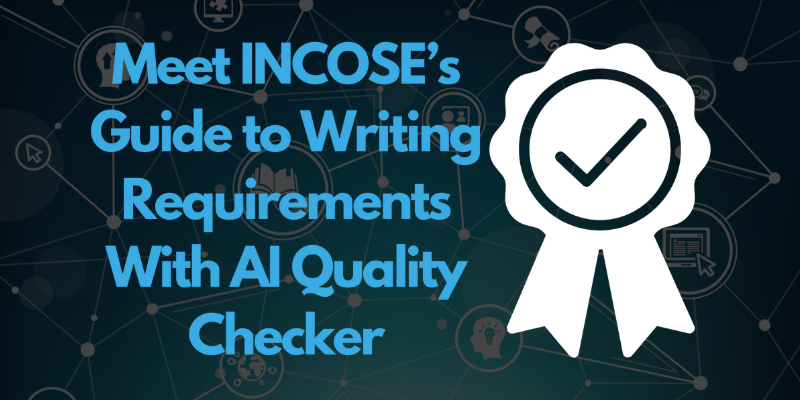How to Write Good Requirements: 10 Tips and Examples
Writing good requirements is essential for the success of any project. Clear, concise, and well-defined requirements set the foundation for a...

In the field of systems engineering and requirements management, clear and effective communication is crucial. The INCOSE Writing Guide, developed by the International Council on Systems Engineering (INCOSE), serves as a vital tool for creating well-structured and precise requirements.
In conjunction with these guidelines, Innoslate continuously updates its software to align with INCOSE’s standards, ensuring that requirements managed within Innoslate meet industry expectations. The Innoslate Quality Checker is an integral part of this effort, designed to automatically review and enhance the quality of system engineering documentation and models.
In this blog, we will explore how the INCOSE Writing Guide's principles are applied, how the Innoslate Quality Checker supports these standards, and writing tips to ensure your requirements are clear and unambiguous.
The INCOSE Writing Guide is a resource developed by the International Council on Systems Engineering (INCOSE) to help professionals in the field of systems engineering create clear, consistent, and effective documentation. It provides guidelines and best practices for writing various types of documents, including requirements specifications, design documents, and reports.
The guide focuses on:
By following the INCOSE Writing Guide, professionals aim to produce high-quality documents that facilitate stakeholder communication and understanding and support successful system development and integration.

The Innoslate Quality Checker is a tool designed to enhance the quality of system engineering documentation and models created within Innoslate. Innoslate is a comprehensive tool for systems engineering and requirements management, and the Quality Checker is one of its features aimed at improving the overall quality of the documents and artifacts produced.
Key functions of the Innoslate Quality Checker include:
The Quality Checker helps streamline the review process, reduce the likelihood of errors, and ensure that documentation is of high quality and suitable for its intended purpose.

Innoslate’s Quality Checker checks for certain attributes within your requirements. Below is a list of words, phrases, and more to use and avoid in your requirements for ambiguity. Use these criteria to ensure your requirements are unambiguous and pass the quality check.
All number values in a requirement should be followed by the unit of measurement from a primary measurement system (i.e., British Imperial, US, Metric). All units of measurement used throughout the requirements document should be consistent with one primary measurement system, whether they are in the abbreviated or regular form.
This follows the INCOSE Rule: R6 - Common Unit of Measure.
Ensure your requirements do not contain words or phrases using the passive voice. The University of Toronto’s article provides more information and examples of passive voice.
This follows the INCOSE Rule: R2 - Active Voice.

Indefinite articles such as "a" and "an" should be replaced by the definite article "the."
This follows the INCOSE Rule: R5 - Definite Articles.
Do not use words/phrases indicating vague terms. Here are some words that provide vague quantification:
| Some | A lot of | About |
| Any | A few | Close to |
| Allowable | Almost always | Almost |
| Several | Very nearly | Approximate |
| Many | Nearly |
Some vague adjectives to avoid are:
| Ancillary | Flexible | Efficient |
| Relevant | Expandable | Effective |
| Routine | Typical | Proficient |
| Common | Sufficient | Reasonable |
| Generic | Adequate | Customary |
| Significant | Appropriate |
Adverbs qualify actions in some way and are particularly troublesome if vague. Avoid vague adverbs, such as “usually,” “approximately,” “sufficiently,” and “typically,” which can lead to ambiguous, unverifiable requirements that do not accurately reflect the stakeholder expectations. Generally, words that end in “-ly” often result in ambiguity.
This follows the INCOSE Rule: R7 - Vague Terms.
Do not use words/phrases indicating escape clauses in your requirements. Escape clauses that state vague conditions or possibilities, such as:
| “so far as is possible” | “to the extent necessary” |
| “as little as possible” | “as appropriate” |
| “where possible” | “as required” |
| “as much as possible” | “to the extent practical” |
| “if it should prove necessary” | “if practicable” |
| “if necessary” |
This follows the INCOSE Rule: R8 - Avoid Escape Clauses.
An infinitive is a verbal consisting of the word “to” + “a verb.” Stay away from phrases indicating unnecessary verbs or passive infinitive phrases such as:
| “to be designed to” | “to enable” |
| “to be able to” | “to allow” |
| “to be capable of” |
This follows the INCOSE Rule: R10 - Avoid Superfluous Infinitives.
Avoid using the word "not” in your requirements. Instead, explicitly state what is required rather than what is not.
This follows the INCOSE Rule: R16 - Use of "Not."
Avoid using the oblique symbol ("/") in your requirements. The symbol is often used to combine synonyms (e.g., symbol/sign), but it can ultimately cause confusion.
This follows the INCOSE Rule: R17 - Use of Oblique Symbol.
Stay away from personal and indefinite pronouns. Some examples of personal pronouns are:
| It | She |
| This | They |
| That | Them |
| He |
Indefinite pronouns are words such as:
| All | Everybody | Nobody |
| Another | Everyone | None |
| Any | Everything | One |
| Anybody | Few | Several |
| Anything | Many | Some |
| Both | Most | Somebody |
| Each | Much | Someone |
| Either | Neither | Something |
| Every | No one | Such |
This follows the INCOSE Rule: R24 - Pronouns.
Make sure your requirements do not contain words for universal qualifiers such as "all," "any," and "both." These should be replaced by the universal quantifier, "each."
This follows the INCOSE Rule: R32 - Universal Qualification.
Avoid words/phrases indicating unmeasurable performance. Unmeasurable words/phrases are ambiguous and need to be replaced by specific quantities within feasible ranges that can be measured. Some words that signal unmeasured quantification are:
| Prompt | Optimum | Medium-sized |
| Fast | Nominal | Best practices |
| Routine | Easy to use | User-friendly |
| Maximum | Close quickly | |
| Minimum | High speed |
This follows the INCOSE Rule: R34 - Measurable Performance.
Do not use indefinite temporal words/phrases in your requirements such as:
| Eventually | As | Instantaneous |
| Until | Once | Simultaneous |
| Before | Earliest | At last |
| After | Latest |
This follows the INCOSE Rule: R35 - Temporal Dependencies.
Make sure to define all acronyms within the project and that each acronym used does not have multiple meanings. For example, do not use AI if your project involves both Artificial Intelligence and Air Interception.
This follows the INCOSE Rule: R37 - Acronyms.
Innoslate’s Acronym Extractor quickly gathers and organizes all document acronyms in a separate reference document.
Tools like the Innoslate Quality Checker can help you comply with the INCOSE Standard and ensure that your requirements are clear and unambiguous.
As you apply the INCOSE Writing Guide and leverage the Innoslate Quality Checker, remember that developing clear, precise, and well-organized requirements is not just a formality but a foundation for effective systems engineering. Ensuring your requirements are well-defined and free from ambiguity will ultimately lead to better project outcomes and system success.
Have questions about model-based systems engineering or requirements management? Talk to an expert and see how Innoslate can streamline your projects from start to finish.

Writing good requirements is essential for the success of any project. Clear, concise, and well-defined requirements set the foundation for a...

Standard Operating Procedures (SOPs) play a vital role in systems engineering, ensuring that complex processes are carried out efficiently and...

2 min read
Don't feel like reading? Watch the webinar recording instead! In systems engineering and project management, the importance of clear and precise...